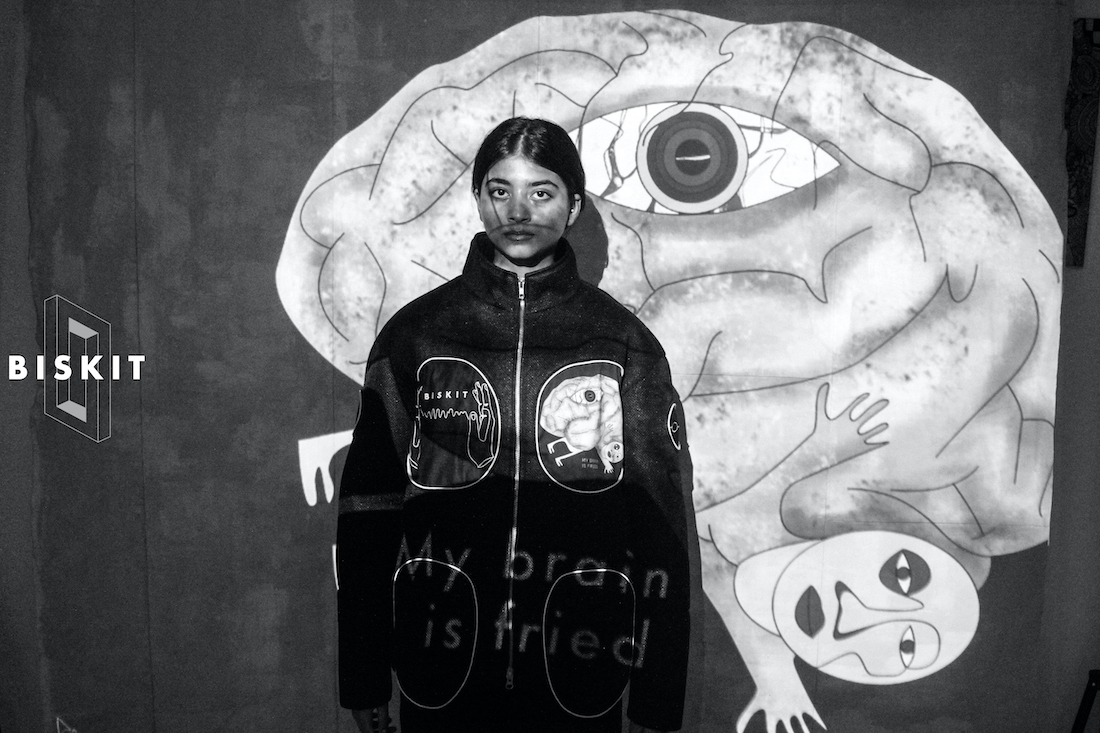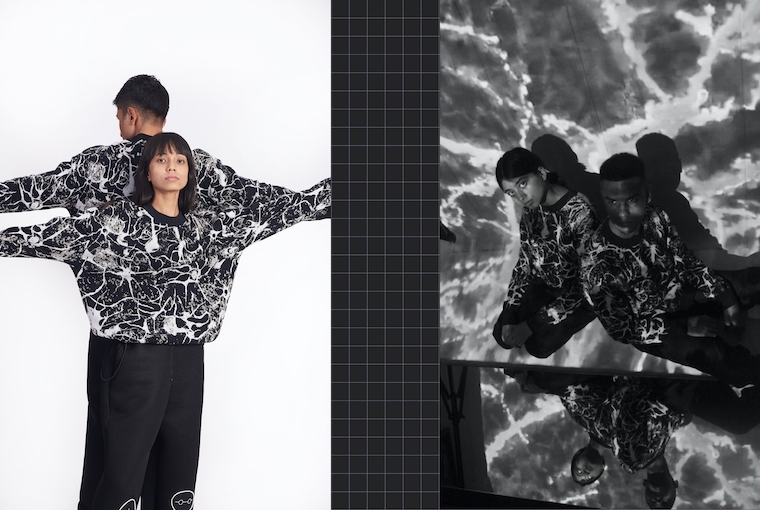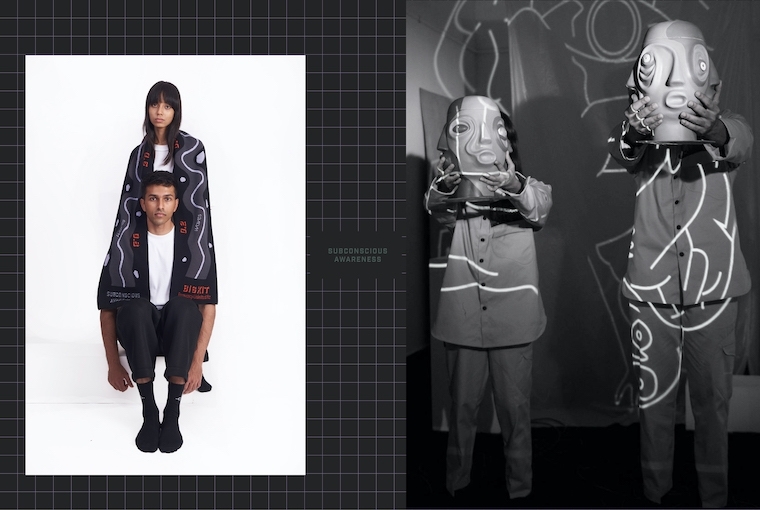

Sibling duo Harsha and Shruti Biswajit were brought up in Madras by artistically inclined parents. Their father, a cartoonist and illustrator, and their mother, a painter and sculptor who owns an art gallery, raised them in a creatively stimulating environment. With the skills that they acquired early on, it was imperative they established their own individual identities. Harsha ventured out to explore the field of visual art and further moved to New York to pursue a masters from SVA in Digital Fine Arts. Shruti on the other hand, went on to study Fashion Design from FIT and then specialised in sportswear with a degree from Politecnico Di Milano.
Harsha vividly recalls that sometime in 2017, post Shruti’s internship with Helmut Lang, while he was in the middle of an Art Residency in France, the duo decided to join forces and set up their own multidisciplinary design studio. A unique amalgamation of both their skills, BISKIT exists today as a synthesis of fashion, art and design, exploring these mediums to the fullest. Their shared encounter with New York City, gave birth to their idiosyncratic design language — a distinct concoction of the Brooklyn vibe and their own background. The intent was to expand the vocabulary of fashion with a label rooted completely in contemporaneity. Furthermore, breaking through the rigid dichotomy of gender, fuelled their unisex concept label.
We’re in conversation with the duo about the studio, their latest drop and more.
The First Interaction
Shruti Biswajit: Interestingly enough, our connection to textiles goes a long way back. Our grandfather owned a textile mill in South India, that used to spin yarn. I remember as kids we would often visit the factory and roam around the giant warehouse space for hours on end. In fact, both of us have a distinct memory of rollerblading through the hallways, from one giant room to another. We kind of forgot about this actually and it only came back to us when you asked us about it!
The Motivation
Harsha Biswajit: To give you a little context, rather than creating collections based on seasons, at BISKIT we only work with concepts. Everything we make is inspired by the main idea(s) we are exploring at the time. We started our studio in 2017 by exploring ‘SPACE’. It was the same time when India launched 102 satellites into outer space, which suddenly changed the global perception of India’s Space Program. This was super interesting to us and we wanted to dig deeper into our own past and tell the story of space through this lens, rather than a purely western perspective, which is always the stereotypical point of view. So we had references to Rakesh Sharma, ISRO, Images of Mars taken by Indian Space Crafts, and so on.
Since the beginning of 2020, we started thinking about what we wanted to explore next and the idea to explore the inner workings of the mind grew organically as the year played out the way it did. For all of us, 2020 became a year of introspection — a moment to slow down and spend quality time with our own thoughts — and this was the starting point for our second concept. The interesting thing is that the galaxy of our inner space is as complex and unfamiliar as the space that surrounds our world. Even visually, as we compare the formation of galaxies lightyears away and the makeup of our physical bodies on a microscopic level, there are so many similarities. A short film created by Charles and Ray Eames in the 1970s illustrates this idea and it's also part of our concept video. It’s fascinating! So we really loved how conceptually we could transition from SPACE to MIND, which opened up a lot of areas for us to explore such as imagination, perception, language, memory, and dreams.
Finally, we wanted to use this concept to convey positive energy, considering our collective present moment. While we were given a chance to reflect in 2020, it also became the year that created increased anxiety and emotional stress for a lot of people. One aspect of this was our balance with the digital world. We want to encourage a habit of consciously disconnecting from it every so often and instead channel our inner minds to re-energize and re-balance ourselves. So you can expect to find within this concept, things that help bridge that balance through art and design.
MIND
HB: We have words and structures to help us organize the immense complexity of life. These disciplines are of course man-made divisions, and to consider them opposing isn’t really as important as to consider that they are just approaching the same problem from different perspectives. It might sound over used, but the world is indeed connected, and as artists, we have the freedom to take inspiration from anywhere, unlike most other professions that live within their own boundaries. For us, this is the whole point of why we decided to start BISKIT. Our backgrounds as artists allow us to approach things in our own unique way. We go to anything that inspires us and allows us to understand the world a little better, which we then hopefully can communicate through the work we do.
SB: We launched the concept with six art prints and six pieces of clothing. Our ‘frequency’ art prints were designed to set the stage for the story. They explore brain waves that humans generate, which influence the five general states of mind — from deep-sleep state, dream state, meditative state, awake state and finally to a state of heightened perception — that we all experience and move between throughout the day and our lives. For a little bit of fun, we added a sixth imaginary state, the ‘BISKIT STATE’. Arguably the most desired state, which you can tune in to by experiencing ‘our world’, a reflection of the subconscious mind.
Our approach to materials for this concept was simple — to find fabric that enhances our story, but at the same time, aligns with our conscious design philosophy. So we’ve worked with organic cotton and repurposed fabric wherever possible. All our pieces, apart from our knit sweater and scarf, are handmade in our studio in Madras and stitched together using thread made from recycled plastic. This is certainly not the end, but only the beginning of us exploring the mind. We spent four years and counting exploring ‘space’, so we still haven’t even scratched the surface of this concept. We will be releasing more as the year goes by — expanding our medium from clothes and art prints to design objects, and sound installations — at least in the near future. This is all we can say now.

My Brain is Fried
One of our favourite pieces so far from the collection is our ‘My Brain is Fried’ Mesh Jacket. This piece explores the feeling of our brain, which is like a hard drive, getting overheated and fried when we over expose ourselves to the digital world. It encourages us to generate ‘Biskit Waves’, to reset and bring ourselves back to a calm state of mind. The left sleeve contains the ‘on’ circuit symbol, referring to our brains being turned on when we wake up and connect to the world. The Patch on the left side of the jacket is our ‘my brain is fried’ artwork, that refers to the brain getting overheated with unnecessary information. The right side of the jacket has our ‘Biskit waves’ artwork featuring two hands — a symbol of healing. The right side of the sleeve has the ‘off’ circuit symbol referring to the need to switch off from the digital world and negative thoughts. Finally, our ‘neuron’ print on the back of the jacket displays the importance of neurons in the functioning of the brain. The neuron print also features separately in our black and white ‘Neuron Sweater’. So as you can tell, every piece has meaning, a story, and sometimes a concept within a concept.
The Research
SB: The research still continues as the concept evolves! The books Ikigai and Mind to Matter were the starting point in the journey. They showed us how we have the power to change our thinking, means for existing, and to really feel and reflect positivity. We became obsessed with reading articles, listening to podcasts, and watching documentaries related to the power of the mind. That led to a lot of research into the structure of the brain, the potentiality of the mind and the non-local domain where our vital energies and consciousness operate. We viewed these paradoxical concepts through the lens of physicists, philosophers and people in the quantum space, who were integrating both science and spirituality in their studies, to prove that it was possible to change the course of the mind and simultaneously encounter the true meaning of self and happiness. We all understand how our outer experience of the world influences our inner state of mind, but to see it broken down on a neuron level, we suddenly can visualize what’s happening inside.
Gender Neutrality
HB: So I think the only way to begin talking about how we approach our design philosophy is by taking the word ‘gender’ completely out of the conversation. Using this word here creates a lot of misconceptions about what it means to design a piece of clothing that can be worn by anyone. The word that we prefer to use is ‘unisex’, in which the prefix ‘uni’ describes a singular nature and takes the related sense shared. Therefore, unisex means shared by the sexes. This implies a shift in perspective from looking at clothes from a purely gender perspective, to approaching it from a point of view of design and what it stands for.
There are two ideas that shape everything we do at BISKIT. The first is that we want to give the choice back to the people to decide if they are comfortable wearing a piece of clothing instead of it being pre-determined by the industry. The second is that we believe that designing with a unisex philosophy allows us to do our part to consciously think about reducing over-production and over-consumption. We have to remember that the idea of fabric being assigned a specific gender on a mass scale was something that only became mainstream during the industrial era, before which clothes were less rigid and made based on need. Today, the mass production mentality is still prevalent because it prioritizes profit over planet. This we feel is an archaic idea, so why should we continue to make two of the same piece of clothing when we can make one and share it? While we understand that not everything needs to be and can be unisex, in general if more clothes were designed this way, we would not need to make duplicates of the same design for men and women, just because its more efficient to produce, market and sell them individually.
Being conscious of how much we produce and consume as a society is something that we have cared about right from the beginning. This reflects throughout BISKIT — from repurposing our waste scraps, having limited sizing to more recently being more transparent about how much we produce in total. In 2021, as part of a new initiative, we decided to further limit our production by deciding to only make either single-edition pieces (one-offs) or a maximum of 21 editions of every style we make moving forward. We use values inbuilt in the ‘unisex’ philosophy to encourage, through design, the concept of sharing — buy less, use more. Imagine if this is how we made choices about what we wear on an everyday basis; imagine the impact we could have as a country. Just considering the size of our population, a small change in perspective and mindset would have a massive impact globally. So we are very excited with the prospect of spearheading this movement.

The Pandemic and Beyond
HB: The pandemic has been challenging for everyone. However it has given us a lot of time to reflect and think about what really matters to us, both as individuals and as a company. As soon as the pandemic hit, we immediately shifted our focus for a while to make face-masks and use the proceeds towards donating face shields for those on the front lines. For our community online, we initiated a small art campaign, where we invited anyone to draw a face for every day of the week, as a way to be positive and stay creative while we were all stuck at home. I feel these were meaningful connections that we were able to cultivate during these tough times, and in our own small way, help people through BISKIT. If there is one thing 2020 has taught us, it's that we have no clue what's coming up next! Having said that, we are very optimistic about the future.
Text Unnati Saini
Date 11-05-2021